IPRP and International HRM
Critically evaluate the extent to which individual performance related pay can stimulate higher levels of performance from employees, considering contextual issues and individual differences.
24 Pages6484 Words78 Views
Added on 2023-06-04
About This Document
This essay analyzes the extent to which Individual performance related pay stimulates higher job performance among employees, the circumstances under which it works well and the ones in which it does not.
IPRP and International HRM
Critically evaluate the extent to which individual performance related pay can stimulate higher levels of performance from employees, considering contextual issues and individual differences.
Added on 2023-06-04
ShareRelated Documents
IPRP and International HRM
IPRP and International HRM
Student’s Name
Instructor’s Name
Course Number
Date
IPRP and International HRM
Student’s Name
Instructor’s Name
Course Number
Date

IPRP and International HRM
Individual performance related pay and its link to motivation
Introduction
Individual performance-related pay has grown significantly in the recent years more so in the
manufacturing sector in a bid to improve the performance of employees. It is a monetary reward
of employees whose performance has reached or surpassed a required standard. According to
Kvaløy & Olsen (2012) it is generally used in circumstances where employee performance
cannot be reliably measured using other standards such as sales achieved. Employees are
regularly reviewed against set standards and grouped into various performance categories which
determine their level of compensation. IPRP is different from other incentive methods that are
company or team based as it is performance and formula driven and payments are once off. This
essay analyses the extent to which Individual performance related pay stimulates higher job
performance among employees, the circumstances under which it works well and the ones in
which it does not. In doing so, it takes into account various the contextual issues such as the
standard income, individual differences, type of occupation among others.
The extent to which performance related pay motivates employees for higher performance.
Motivation involves activating or inducing job performance that is goal-oriented among
employees. According to Rathore & Chadha (2013) the management Is often faced with the
challenge of satisfying employees as it has a significant impact on efficiency and productivity, it
impacts on employees attitudes, behaviors and their willingness to perform tasks and attend to
their responsibility, the extra effort they apply, and their efficiency in performing duties.
Motivation towards work can be classified into intrinsic and extrinsic motivation. Intrinsic
Individual performance related pay and its link to motivation
Introduction
Individual performance-related pay has grown significantly in the recent years more so in the
manufacturing sector in a bid to improve the performance of employees. It is a monetary reward
of employees whose performance has reached or surpassed a required standard. According to
Kvaløy & Olsen (2012) it is generally used in circumstances where employee performance
cannot be reliably measured using other standards such as sales achieved. Employees are
regularly reviewed against set standards and grouped into various performance categories which
determine their level of compensation. IPRP is different from other incentive methods that are
company or team based as it is performance and formula driven and payments are once off. This
essay analyses the extent to which Individual performance related pay stimulates higher job
performance among employees, the circumstances under which it works well and the ones in
which it does not. In doing so, it takes into account various the contextual issues such as the
standard income, individual differences, type of occupation among others.
The extent to which performance related pay motivates employees for higher performance.
Motivation involves activating or inducing job performance that is goal-oriented among
employees. According to Rathore & Chadha (2013) the management Is often faced with the
challenge of satisfying employees as it has a significant impact on efficiency and productivity, it
impacts on employees attitudes, behaviors and their willingness to perform tasks and attend to
their responsibility, the extra effort they apply, and their efficiency in performing duties.
Motivation towards work can be classified into intrinsic and extrinsic motivation. Intrinsic
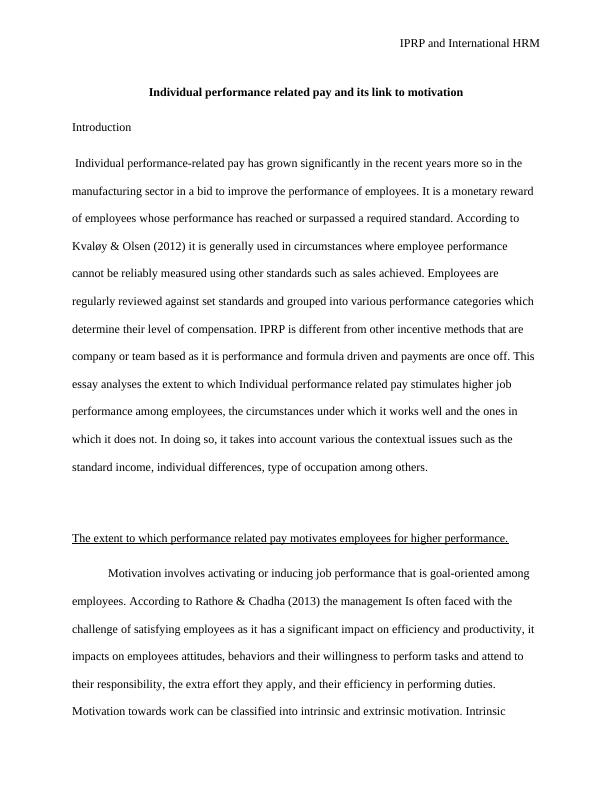
IPRP and International HRM
motivation revolves around the value obtained from the work itself while extrinsic motivation, is
about the additional value not derived from the work. Intrinsic values are such as increased
responsibility, recognition, advancement, excellent interpersonal relationship while bonuses and
salaries are good examples of extrinsic values. If employees are satisfied with the reward system
then the extrinsic variables may be different and independent of intrinsic variables. Motivating
employees is significant in achieving the overall objectives of the organization. Motivation may
be viewed as psychological factors that determine an individual’s behavior in his/her
organization, the amount of effort applied and the persistence level of an employee (Bruce and
Pepitone 2012, pp67-72). The effort is a clear reflection of the amount of hard work put in by an
employee. According to Trout (2017) persistence is achieved where employees work in tough
conditions continuously without giving up. Employees view their salary as compensation for
services rendered to the employer. They consider it as the value placed on them in their
workplaces and in terms of their expertise and the level of training or education they have
achieved. Managers, on the other hand, view salaries and wages from two angles: being
significant expenses and as a way to impact on employees' performance through reward-based
motivational schemes. This ability to influence employees' behavior and attitudes as well as the
efficiency and productivity of the organization, is the main reason leading many people to
appreciate the motivational effect of performance-related pay on employees.
Designing and Implementation of a reward strategy is among the significant investments
made by an organization. Although an appropriate salary is the basis of the implied and
contractual agreement between the employer and the employees, the general assumption is that
money has the ability to influence attitudes and behavior. Lauby (2009) believes that majority of
employers and company directors believe an increase in the employee's salary increases their
motivation revolves around the value obtained from the work itself while extrinsic motivation, is
about the additional value not derived from the work. Intrinsic values are such as increased
responsibility, recognition, advancement, excellent interpersonal relationship while bonuses and
salaries are good examples of extrinsic values. If employees are satisfied with the reward system
then the extrinsic variables may be different and independent of intrinsic variables. Motivating
employees is significant in achieving the overall objectives of the organization. Motivation may
be viewed as psychological factors that determine an individual’s behavior in his/her
organization, the amount of effort applied and the persistence level of an employee (Bruce and
Pepitone 2012, pp67-72). The effort is a clear reflection of the amount of hard work put in by an
employee. According to Trout (2017) persistence is achieved where employees work in tough
conditions continuously without giving up. Employees view their salary as compensation for
services rendered to the employer. They consider it as the value placed on them in their
workplaces and in terms of their expertise and the level of training or education they have
achieved. Managers, on the other hand, view salaries and wages from two angles: being
significant expenses and as a way to impact on employees' performance through reward-based
motivational schemes. This ability to influence employees' behavior and attitudes as well as the
efficiency and productivity of the organization, is the main reason leading many people to
appreciate the motivational effect of performance-related pay on employees.
Designing and Implementation of a reward strategy is among the significant investments
made by an organization. Although an appropriate salary is the basis of the implied and
contractual agreement between the employer and the employees, the general assumption is that
money has the ability to influence attitudes and behavior. Lauby (2009) believes that majority of
employers and company directors believe an increase in the employee's salary increases their
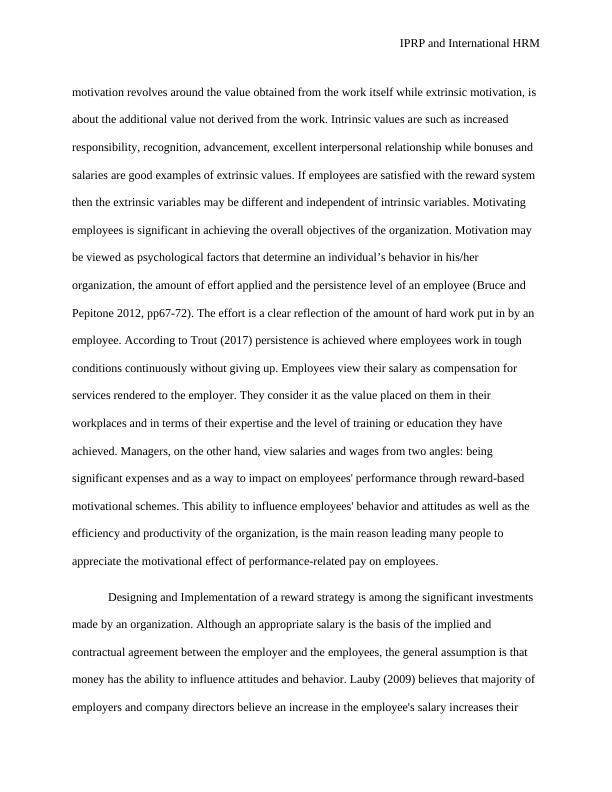
IPRP and International HRM
motivation, productivity, and loyalty. The impact of compensation strategy is a significant factor
in every organization and that job performance is a vital issue for many organizations because
they need to attract, motivate and retain the most appropriate talent pool for the organization to
achieve its objectives. According to Anon (2016) Individual performance-related pay that is
well-designed can pull employees together and motivate them to move in the direction
management wants them to perform. It has the ability to improve the decisions and choices made
by individuals and hence enhances employee performance. A research of 84 subjects by Stone
showed that performance-related pay resulted in changes in attitudes, behavior and improved as
well as informed decision making.
Individual performance related pay may work but only for some time and to some extent.
In the early stages, employees are tempted to work towards the set standards so as to improve
their pay but then once they realize that their performance and application of skills is being
completely controlled by the management, their enthusiasm drops .The reason behind this is that
people hate being controlled thus performance-related pay is only successful in ensuring
temporary compliance. Moreover, offering rewards to individuals who are already intrinsically
motivated undermines their intrinsic motivation. According to East (2008) employees are
basically interested in their jobs and employ a certain level of expertise thus recognizing this
expertise through including them in the decision making process is a better motivation tool.
Performance related pay also reminds workers of the power gap in the organization. They are
reminded that the management takes home a huge amount of salaries compared to them hence a
demotivating factor.
motivation, productivity, and loyalty. The impact of compensation strategy is a significant factor
in every organization and that job performance is a vital issue for many organizations because
they need to attract, motivate and retain the most appropriate talent pool for the organization to
achieve its objectives. According to Anon (2016) Individual performance-related pay that is
well-designed can pull employees together and motivate them to move in the direction
management wants them to perform. It has the ability to improve the decisions and choices made
by individuals and hence enhances employee performance. A research of 84 subjects by Stone
showed that performance-related pay resulted in changes in attitudes, behavior and improved as
well as informed decision making.
Individual performance related pay may work but only for some time and to some extent.
In the early stages, employees are tempted to work towards the set standards so as to improve
their pay but then once they realize that their performance and application of skills is being
completely controlled by the management, their enthusiasm drops .The reason behind this is that
people hate being controlled thus performance-related pay is only successful in ensuring
temporary compliance. Moreover, offering rewards to individuals who are already intrinsically
motivated undermines their intrinsic motivation. According to East (2008) employees are
basically interested in their jobs and employ a certain level of expertise thus recognizing this
expertise through including them in the decision making process is a better motivation tool.
Performance related pay also reminds workers of the power gap in the organization. They are
reminded that the management takes home a huge amount of salaries compared to them hence a
demotivating factor.
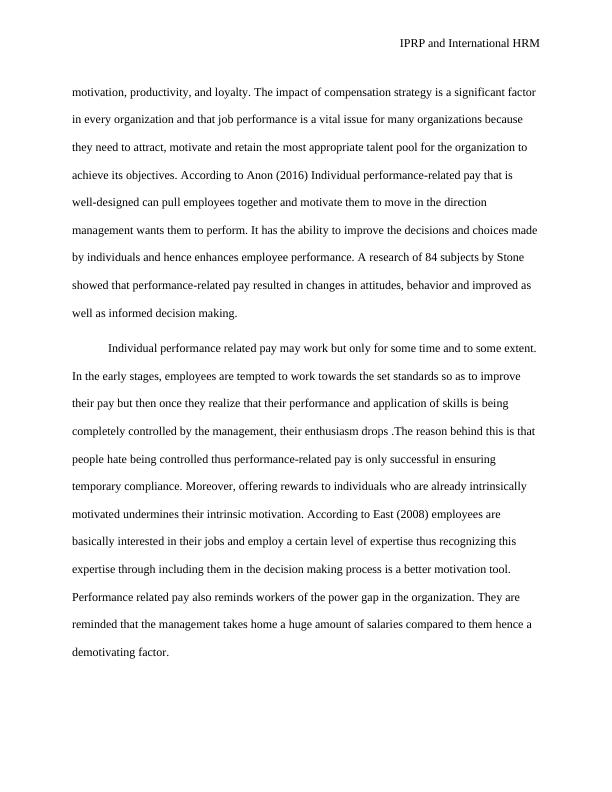
IPRP and International HRM
In addition, employees are well aware of the basis of their merit pay hence forget about
all the other non-measurable aspects of the job such as innovation and creativity and focus all
their energy on the measurable aspects on which their pay is based on. They work with a reward
set mind and shift their focus from the task to the reward. They also may conceal any challenges
they encounter in their work so as to prove their expertise to the supervisor. They also become
averse to risk and resist from exploring new possibilities as they prefer simplicity and
predictability hence creativity is significantly hindered. Mcnabb (2018) indicates that if
employees are paid more than they deserve in terms of salaries, they will not have contributed to
the attainment of objectives and competitive advantage will be negatively impacted. According
to Kragl (2015) there are often minimal variances in the set standards and actual performances.
This trend of overrating employees is rampant in parts of Africa where it has negative impacts on
motivation and efficiency. People will often be unwilling to assess others negatively in their
workplaces more so in relation to compensation matters because they do not want to be accused
as the reason behind low levels of wages in their divisions as opposed to other divisions where
fellow employees might be earning huge salaries. The situation may lead to rivalry among
divisions and conflicts among supervisors and employees.
Individual performance pay may not also impact motivation if it is not directed to the
appropriate people. This kind of reward system may not motivate managers as such as it may
motivate junior employees. This is in accordance to Milkovich and Wigdor’s research, which
found out that, among other factors, that performance-related pay schemes work best under jobs
in which the responsibilities can be reliably measured and are concrete. Differentials in
efficiency, however, should not be overstated. These findings are in contrary to existing beliefs
that performance-related pay strategies are more motivational and effective at higher levels of
In addition, employees are well aware of the basis of their merit pay hence forget about
all the other non-measurable aspects of the job such as innovation and creativity and focus all
their energy on the measurable aspects on which their pay is based on. They work with a reward
set mind and shift their focus from the task to the reward. They also may conceal any challenges
they encounter in their work so as to prove their expertise to the supervisor. They also become
averse to risk and resist from exploring new possibilities as they prefer simplicity and
predictability hence creativity is significantly hindered. Mcnabb (2018) indicates that if
employees are paid more than they deserve in terms of salaries, they will not have contributed to
the attainment of objectives and competitive advantage will be negatively impacted. According
to Kragl (2015) there are often minimal variances in the set standards and actual performances.
This trend of overrating employees is rampant in parts of Africa where it has negative impacts on
motivation and efficiency. People will often be unwilling to assess others negatively in their
workplaces more so in relation to compensation matters because they do not want to be accused
as the reason behind low levels of wages in their divisions as opposed to other divisions where
fellow employees might be earning huge salaries. The situation may lead to rivalry among
divisions and conflicts among supervisors and employees.
Individual performance pay may not also impact motivation if it is not directed to the
appropriate people. This kind of reward system may not motivate managers as such as it may
motivate junior employees. This is in accordance to Milkovich and Wigdor’s research, which
found out that, among other factors, that performance-related pay schemes work best under jobs
in which the responsibilities can be reliably measured and are concrete. Differentials in
efficiency, however, should not be overstated. These findings are in contrary to existing beliefs
that performance-related pay strategies are more motivational and effective at higher levels of
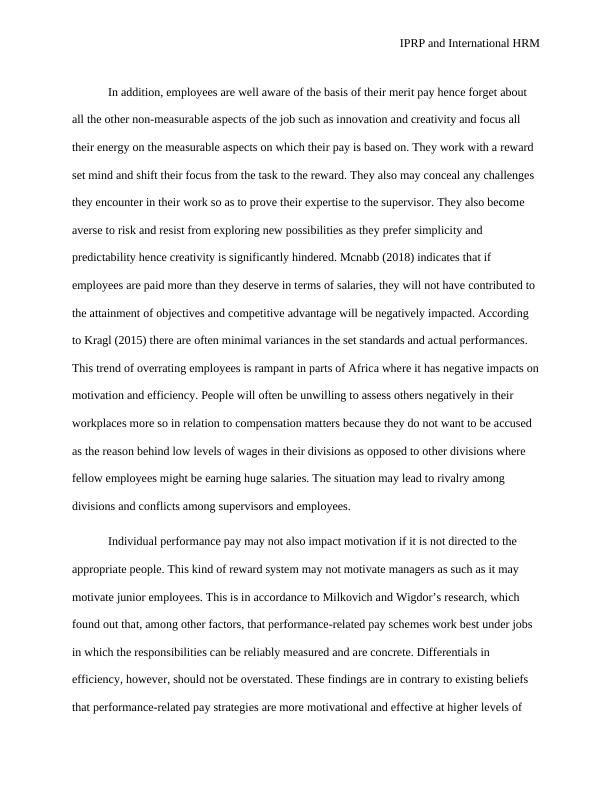
IPRP and International HRM
the organization. Nevertheless, employees ultimately consider the unfairness of the reward
systems. The reason why employees have this perception is not clear but may include low trust
levels among departments and individuals, lack of transparency in the reward system, lack of
trust in the integrity of management and lack of trust in the appraisal systems.
Finally, irrespective of management or work level, improving measurement of job
performance and other appropriate actions that are not related to pay incentives may lead to
improved performance through improvement in the setting of goals. According to the Economist
(2009) the benefits accrued from performance-based pay seem not to originate from the pay itself
but from the improvement in set standards. Performance standards are the most significant
benefit accrued from performance related pay as shown by various studies. In most cases
introducing pay into performance measurement leads to adverse changes in the performance of
employees.
Circumstances under which IPRP tends to motivate employees
Where equity and efficiency are highly observed. The firm may purchase employee motivation
and energy to pursue organization objectives by distributing financial rewards in an equitable
and efficient manner. When equity is enhanced the employees feel that they are all valued at the
same level by the organization hence they strive to achieve the set standards of performance. The
gap between employees which is often a demotivation factor is also eliminated. The reward
system must, therefore, be implemented and managed in an efficient manner taking into
consideration the employee's needs.
the organization. Nevertheless, employees ultimately consider the unfairness of the reward
systems. The reason why employees have this perception is not clear but may include low trust
levels among departments and individuals, lack of transparency in the reward system, lack of
trust in the integrity of management and lack of trust in the appraisal systems.
Finally, irrespective of management or work level, improving measurement of job
performance and other appropriate actions that are not related to pay incentives may lead to
improved performance through improvement in the setting of goals. According to the Economist
(2009) the benefits accrued from performance-based pay seem not to originate from the pay itself
but from the improvement in set standards. Performance standards are the most significant
benefit accrued from performance related pay as shown by various studies. In most cases
introducing pay into performance measurement leads to adverse changes in the performance of
employees.
Circumstances under which IPRP tends to motivate employees
Where equity and efficiency are highly observed. The firm may purchase employee motivation
and energy to pursue organization objectives by distributing financial rewards in an equitable
and efficient manner. When equity is enhanced the employees feel that they are all valued at the
same level by the organization hence they strive to achieve the set standards of performance. The
gap between employees which is often a demotivation factor is also eliminated. The reward
system must, therefore, be implemented and managed in an efficient manner taking into
consideration the employee's needs.
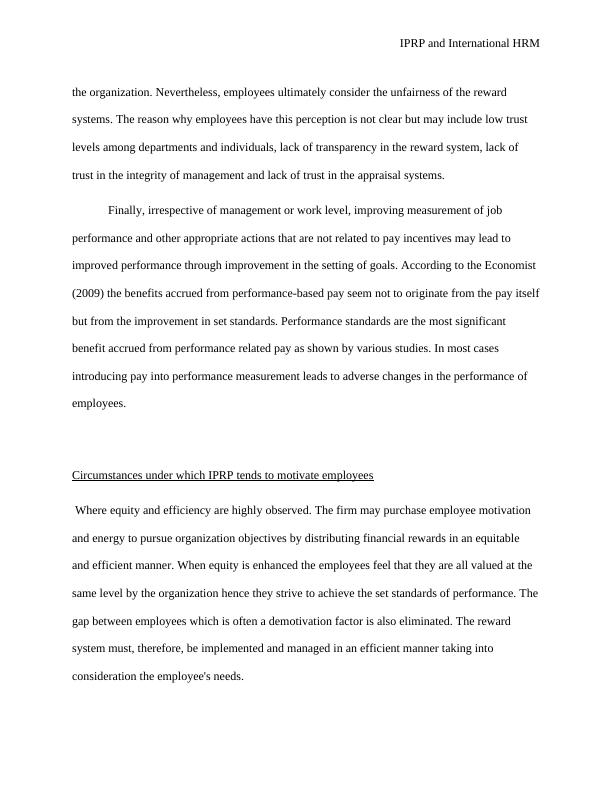
End of preview
Want to access all the pages? Upload your documents or become a member.
Related Documents
Individual Performance Related Pay and Employee Performancelg...
|12
|2640
|163
Individual Performance Related Pay and Employee Motivation in Strategic HRMlg...
|9
|2730
|425
Effectiveness of Individual Performance Related Pay System in Improving Employee Performancelg...
|10
|3476
|449
Strategic Human Resource Managementlg...
|8
|2606
|36
Impact of Individual Performance Related Pay on Employee Performancelg...
|7
|1840
|59
Strategic Human Resource Managementlg...
|15
|5035
|55
